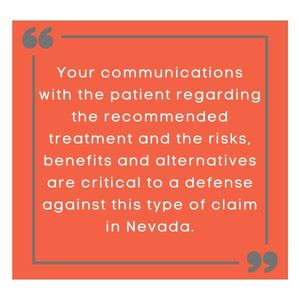
- Compliance
Medical Malpractice Claim: Lack of Informed Consent in Nevada
In Nevada, what are the best practices for informed consent with patients in order to protect your practice in case of a medical malpractice lawsuit?
What must a Nevada plaintiff prove to prevail in a medical malpractice lawsuit alleging lack of informed consent?
A conscientious physician would never perform any procedure or provide medical treatment without obtaining, barring an emergency, the proper informed consent. However, how much time have you actually spent considering the legal implications of the term “informed consent”?
Probably not much. That’s what your lawyer is for, right?
The term “informed consent” lies at the intersection of medical and legal fields and the more any practitioner knows about the informed consent process the better.
You Can Be Sued for Lack of Informed Consent

Many Nevada physicians are unaware that they may be sued for proceeding with a procedure or medical treatment without the patient’s full and complete informed consent. This alone can serve as the basis for a medical malpractice case even if the fact that the complication occurred itself was not below the standard of care. In a case for lack of informed consent, the jury will make the determination regarding whether the defendant physician disclosed information that a reasonable practitioner in the same field of practice would disclose.1 This professional standard must be established by expert testimony at trial.
The Plaintiff must also establish that he or she developed the complications they were not warned about and that they would not have consented to the procedure or medical treatment had they been properly informed.
An example of a case where a physician was found to have failed to provide the patient with information that a reasonable practitioner would have was a physician who failed to inform his patient that there was a risk he could sustain paralyzed vocal cords and an obstructed airway during a total thyroidectomy.2 The patient unfortunately developed these complications and the physician was unable to establish that he had advised him that those serious complications were risks of the thyroidectomy.3
In a second case, the Plaintiff alleged that before performing a subocciptal craniectomy to treat facial tics the defendant physician failed to properly explain the risks of the procedure. Specifically, Plaintiff alleged that the physician did not warn the decedent of the risk of the development of a hydrocephalus or the possibility of death arising from the procedure. The physician testified at trial that he did warn the patient of such risks, but the consent form only stated that the patient was advised of risks, rather than which ones. Unfortunately, the patient did develop a hydrocephalus, which caused the patient to lapse into a coma and die.4
The Plaintiff’s claim for lack of informed consent was allowed to proceed to trial even though the medical malpractice claims had been dismissed. As you will see in the next section, a full and complete informed consent form could have protected these physicians.
What is Informed Consent in the Legal Sense?
A patient provides informed consent to a procedure or medical care if they consent to such care after being informed of the risks, benefits and alternatives. This includes a discussion with the physician of any questions the patient may have about the recommended care. In some states, such as Nevada, the term “informed consent” is subject to statutory requirements. Informed consent is defined in the Patient Bill of Rights in Nevada. Patients in medical facilities such as hospitals and ambulatory surgical centers must be advised of the following information in order to be able to give informed consent.5
- A description of the significant medical risks involved;
- Any information on alternatives to the treatment or procedure if the patient requests that information;
- The name of the person responsible for the procedure or treatment; and
- The costs likely to be incurred for the treatment or procedure and any alternative treatment or procedure.
As a practical matter, the word significant, above, means that in order for a patient to provide informed consent, they do not need to be notified of every single possible complication that could occur. Only notification of significant risks is necessary. Additionally, while the statute does not require that consent be obtained in writing, it is always the best practice to have it in writing and signed by a competent patient.
In a medical negligence lawsuit alleging lack of informed consent, if a physician can establish that he complied with the statutory requirements when obtaining informed consent from the patient, then the physician would be entitled to a conclusive presumption of valid informed consent during trial.6
What this means to you in your practice is that if you set up a procedure ensuring that all the elements of the informed consent statute are in place for every patient, and you have the consent properly in writing, any jury will be instructed to conclude that the patient gave his or her informed consent. In order to for this to occur, the physician must do the following:
- Explain to the patient in general terms, without specific details, the procedure to be undertaken;
- Explain to the patient alternative methods of treatment, if any, and their general nature;
- Explain to the patient that there may be risks, together with the general nature and extent of the risks involved, without enumerating such risks; and
- Obtain the signature of the patient to a statement containing an explanation of the procedure, alternative methods of treatment and risks involved, as provided in this section.
The key difference here is that the signature of a patient on a document explaining all the required information establishes a conclusive presumption that the patient gave informed consent. This is not a list of requirements for a physician. Instead, it provides a roadmap for physicians to follow in order to receive a conclusive presumption at trial. In any lawsuit alleging lack of informed consent, a consent form that explains the items above is a document that will protect your interests. These statutes require only general explanations and discussion of risk, again, without enumerating every detail of the conversation or every known possible complication. However, the more detailed form that you provide the patient, the better evidence you will have to show the jury at a trial.
How can practitioners optimize their informed consent discussions and forms to strengthen the defense of this type of claim?

You are your own best defense against a claim for lack of informed consent. Your communications with the patient regarding the recommended treatment and the risks, benefits and alternatives (including the alternative of doing nothing) are critical to a defense against this type of claim in Nevada. However, in order for this to succeed as a legal defense, it is imperative to also document the details of your discussion in the patient’s chart, separately and aside from the consent form itself. While not required by law, this type of documentation will provide extra protection against these types of claims.
Key Takeaways
Take a look at your consent forms with the above in mind. For the procedures and care you most often provide to patients you should have standard forms prepared that list the significant risks and indicate the benefits and alternatives that were discussed.
Discuss the substance of the form with the patient, and document that conversation separately in the patient’s chart. Don’t delegate this task to medical assistants or nurses. This documentation need not be onerous to be effective. A note in the medical record that you discussed the risks, benefits, and alternatives, as set forth in the consent form, would be beneficial. Document whether the patient had questions and, if so, what they were. You may also mention that the patient was advised to contact you if any questions arose before the procedure.
These tweaks to your regular medical practice will help reduce the risk of lack of informed consent claims and strengthen the defense of any that are filed.
1 Smith v. Cotter, 107 Nev. 267 (1991)
2 Id.
3 Id.
4 Brown v. Capanna, 105 Nev. 665 (1989)
5 NRS 449A.106(6) – applicable to patients of a “medical facility” or “facility for the dependent”
6 NRS 41A.110
